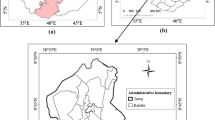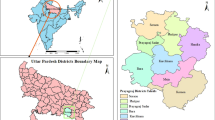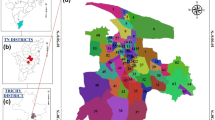Abstract
Egypt governmental reports shows non-optimal geographical distribution of educational facilities and the difficulty in reaching school locations leads to high rates of early school drop-out. Reports showed that 2.75% of school dropout in Mansura city-Egypt (the case study) was due to spatial factors related to the difficulty of reaching school. Urban Planning Authority's report endorse that, the primary school location and the residential building must range between 500–750 m. However, such recommendations failed to take into attention or abided by a developing country like Egypt. The study goes through two Scenarios: (i) Scenario No. 1. Evaluating current school locations and (ii) Scenario No. 2. Analyzing proposed school locations and assess accessibility effectiveness after the process of schools’ geographical redistribution, it was carried out using GIS environment. The study objectives are about examined the role of spatial modeling and location analysis for improving the accessibility to public primary schools in Egypt: The specific aim of the study (i) Showing geographic distribution of public primary Schools in Mansura city. (ii) Examining the accessibility to Public Primary Schools in Mansura city and (iii) Using GIS tools to propose optimum locations where future public primary schools ought to be located. The study manipulated location-allocation models in GIS being one of the location analyses tools. It supports the process of spatial decision-making through several models and various scenarios. These provides varied options and great flexibility during planning. For analyzing the current situation of primary schools' distribution, GIS spatial analysis tools were used such as: Average Nearest Neighbor, Hotspot analysis and Grouping analysis. Study results concluded that number of demand points exceeds the distance of arrival at the optimal standard was about 54.96%. Schools concentration ratio in the city was 71.74% fell to 19.77% after the process of geographical redistribution of school locations. The proposed map of primary school locations in Mansura city can give a clear view for the decision maker on what location-allocation models can contribute for improving accessibility to educational facilities through applying the reliable standards.









Similar content being viewed by others
References
Abdullah, A.S. (2001). Primary education in Egypt, a study in the geography of services, the Arab Geographical Magazine, No. 37, part one.
Al-Baghdadi, MM. (1992). Education and health in ismailia, study in geography of services, Ph. D thesis, Faculty of Arts, Ain Shams University.
Al-Bakir, M. F. (1990). The educational geography of al buhaira governorate geographical study. Damaris: Minia University.
Arifin, S. (2011). Location allocation problem using genetic algorithm and simulated annealing: A case study based on school in Enschde. The Netherlands: Enschede.
Balcik, B., & Beamon, B. (2008). Facility location in humanitarian relief. International Journal of Logistics-research and, 11, 101–121. https://doi.org/10.1080/13675560701561789.
Bennett, W. D. (1981). A location-allocation approach to health care facility location: A study of the undoctored population in Lansing, Michigan, Social Science and Medicine. Part D Medical Geography, 15(2), 305–312.
Bulti, D. T., Bedada, T. B., & Diriba, L. G. (2019). Analyzing spatial distribution and accessibility of primary schools in Bishoftu Town Ethiopia. Spatial Information Research, 27(2), 227–236. https://doi.org/10.1007/s41324-018-0227-6.
Buzai, G. (2013). Location–allocation models applied to urban public services. Spatial analysis of Primary Health Care Centers in the city of Luján, Argentina. Hungarian Geographical Bulletin, 62, 387–408.
Central Agency for Public Mobilization and Statistics. (2017). Final results of the general census of population and establishments, Dakahleya Governorate (pp. 47, 63, 55, 19).
Christian Krog Lindeskov. (2002). Ambulance allocation using gis, informatics and mathematical modelling, Technical University of Denmark, DTU, IMM-EKS-2002-49, (p. 21).
Church, R.L. (1999). Location modeling and GIS. pp.293–303 in Longley, Goodchild, Maguire and Rhind, eds. (p. 300).
Church, R. (2002). Geographical information systems and location science. Computers and Operations Research., 29, 541–562. https://doi.org/10.1016/S0305-0548(99)00104-5.(PP.544-550).
Church, R., & Medrano, F. A. (2018). Location-allocation modeling and GIS. In J. P. Wilson (Ed.), The geographic information science and technology body of knowledge. https://doi.org/10.22224/gistbok/2018.3.4.
Church, R.L., Revelle, C.S. (1974). The maximal covering location problem Papers of the Regional Science Association, 32, pp. 101–118.
Church, R. L., & Sorensen, P. (1994). Integrating normative location models into GIS: Problems and prospects with the p-median model (94–5). UC Santa Barbara: National Center for Geographic Information and Analysis.
Daskin, M. S., & Dean, L. K. (2004). Location of health care facilities, chapter 3 in the handbook of OR/MS in health care. In F. Sainfort, M. Brandeau, & W. Pierskalla (Eds.), A handbook of methods and applications (pp. 43–76). Boston: Kluwer.
Egyptian Ministry of Education, Strategic Plan for Pre-University Education 2014–2030, https://www.unesco.org/education/edurights/media/docs/c33b72f4c03c58424c5ff258cc6aeaee0eb58de4.pdf . Accessed 9 Jul 2020.
El-Deeb, M. M. I. (1993). Localization the nuclear power plant, the case of Al-Dabaa project, Egypt, an Empirical Study. Egyptian Geographical Journal, 25, 95–150.
Farahani, R.Z., Abedian, M., Sharahi, S. (2009). Dynamic facility location problem. https://doi.org/10.1007/978-3-7908-2151-2_15.
Gao, Y., He, Q., Liu, Y., Zhang, L., Wang, H., & Enxiang, C. (2016). Imbalance in spatial accessibility to primary and secondary schools in China: Guidance for education sustainability. Sustainability., 8, 1236. https://doi.org/10.3390/su8121236.
Gerard, R. (1979a). Optimal location of facilities. Wentworth: COMPress, Inc.
Ghanem, I. A. (1988). Linear programming and optimization of economic resources: An empirical study of mathematical models in economic geography. Egyptian Geographical Journal, 20, 161–189.
Harper, P. R., Shahani, A. K., Gallagher, J. E., & Bowie, C. (2005). Planning health services with explicit geographical considerations: A stochastic location–allocation approach. Omega, 33(2), 141–152. https://doi.org/10.1016/j.omega.2004.03.011.
Hoover, E. M. (1948). The location of economic activity. New York: McGraw-Hill Book Company, Inc.
http://desktop.arcgis.com/en/arcmap/latest/extensions/network-analyst/algorithms-used-by-network-analyst.htm. Accessed Oct 2019.
https://search.emis.gov.eg. Accessed Jan 2019.
Inca, L., & Nikorn, S. (2019). The location-allocation decision under the dynamic increment of demand for selecting the local distribution centers to face sumatra megathrust: Study case of Padang city. International Journal on Advanced Science Engineering and Information Technology, 9, 293.
Lee, J. (1992). Location-Allocation analysis of retailing using microsoft windows, Miami university, Computer Science and Systems Analysis, Technical Reports. MU-SEAS-CSA-1992-004, (p. 8).
Lee, T.W.P., Hodgart, R.L. (2014). expert spatial decision support system: A case study of hospital location-allocation analysis in the Lothian region, Scotland, Institute for Computer-Aided Planning, University of Akron. (p. 2).
Menezes, R., & Pizzolato, N. (2014). Locating public schools in fast expanding areas: Application of the capacitated p-median and maximal covering location models. Pesquisa Operacional., 34, 301–317. https://doi.org/10.1590/0101-7438.2014.034.02.0301.(P.304).
Mestre, A. M., Oliveira, M. D., & Barbosa- Póvoa, A. P. (2015). Location-allocation approaches for hospital network planning under uncertainty. European Journal of Operational Research, 240(3), 791–806.
Ministry of Housing, Utilities and Urban Communities. (2014). Directory of Planning Standards for Services in the Arab Republic of Egypt: Volume I, Educational Services (p. 29).
Mirzapour, A., Wong, K., & Govindan, K. (2013). A capacitated location-allocation model for flood disaster service operations with border crossing passages and probabilistic demand locations. Mathematical Problems in Engineering. https://doi.org/10.1155/2013/507953.
Murray, A. T. (2010). Advances in location modeling: GIS linkages and contributions. Journal of Geographical Systems, 12, 335–354.
Murray, A. (2013). Optimising the spatial location of urban fire stations. Fire Safety Journal., 62, 64–71. https://doi.org/10.1016/j.firesaf.2013.03.002.
Naharudin, N. (2014). Application of location/allocation models and gis to the location of national primary schools in Rawang. Malaysia: Institute of Geography The University of Edinburgh.
Owen, S. H., & Daskin, M. S. (1998). Strategic facility location: A review. European Journal of Operational Research, 111, 423–447.
Polo, G., Acosta, C. M., Ferreira, F., & Dias, R. A. (2015). Location-allocation and accessibility models for improving the spatial planning of public health services. PLoS ONE, 10(3), e0119190. https://doi.org/10.1371/journal.pone.0119190(P.2).
Radiah Shariff, S. S., Moin, N. H., & Omar, M. (2012). Location allocation modeling for healthcare facility planning in Malaysia. Computers and Industrial Engineering, 62(4), 1000–1010.
Rahman, S., & Smith, D. (2000). Use of location-allocation models in health service development planning in developing nations. European Journal of Operational Research., 123, 437–452. https://doi.org/10.1016/S0377-2217(99)00289-1.(P.437).
Ramanathan, S., John, D. (2010). Spatial decision support systems: Principles and practices. https://doi.org/10.1201/b10322. (p. 440).
Rushton, G. (1979b). Optimal location of facilities. Wentworth: COMPress, Inc.
Rushton, G. (1984). Use of location-allocation models for improving the geographical accessibility of rural services in developing countries. International Regional Science Review, 9(3), 217–240.
Tang, P., Xiang, J., Luo, J., & Chen, G. (2017). Spatial accessibility analysis of primary schools at the county level based on the improved potential model: A case study of Xiantao City Hubei Province. Progress in Geography, 36(6), 697–708.
Tong, D., & Murray, A. (2012). Spatial optimization in geography. Annals of the Association of American Geographers. https://doi.org/10.1080/00045608.2012.685044.(P.1293).
Tong, D., & Murray, A. T. (2017). Location analysis: developments on the horizon. In R. Jackson & P. Schaeffer (Eds.), Regional research frontiers - advances in spatial science (The regional science series). Cham: Springer.
Xiao, N. (2005). Geographic optimization using evolutionary algorithms. In: 8th International Conference on GeoComputation, University of Michigan, USA (pp.2, 3).
Funding
The author declares that this work is not funded.
Author information
Authors and Affiliations
Contributions
The manuscript was written by the author.
Corresponding author
Ethics declarations
Conflict of interest
The author declare that he has no conflict of interest.
Availability of data and material
The data that support the findings of this study are available from the author upon reasonable request.
Human and animal rights
The author did not involve human participants or animals.
Informed consent
The author did not involve the collection of any personally identifying data, nor anything that could be construed as identifying an individual, hence informed consent was not relevant.
Additional information
Publisher's Note
Springer Nature remains neutral with regard to jurisdictional claims in published maps and institutional affiliations.
Appendix 1 The technical report for study analysis tools.
Appendix 1 The technical report for study analysis tools.
Analysis tool | Tool inputs | Tool outputs | Tool description |
|---|---|---|---|
Standard distance | School locations (point layer) Residential blocks (point layer) Circle Size (1_STANDARD_DEVIATION—1 standard deviation) | For measuring the compactness of primary schools and residential blocks in Mansura city | Measuring the compactness of a distribution provides a single value representing the dispersion of features around the center. The value is a distance, so the compactness of a set of features can be represented on a map by drawing a circle with the radius equal to the standard distance value. The Standard Distance tool creates a circle polygon |
Directional distribution | School locations (point layer) Residential blocks (point layer) Circle size (1_STANDARD_DEVIATION—1 standard deviation) | For measuring directional trends of primary schools and residential blocks in Mansura city | Creates standard deviational ellipses to summarize the spatial characteristics of geographic features: central tendency, dispersion, and directional trends |
Optimized hot spot analysis | Residential blocks (point layer) | For creates a map of statistically significant hot and cold spots for primary schools and residential district in Mansura city | Given incident points or weighted features (points or polygons), creates a map of statistically significant hot and cold spots using the Getis-Ord Gi* statistic. It evaluates the characteristics of the input feature class to produce optimal results |
Buffer analysis | The central feature of residential blocks Distance [value or field]: 1000 M | For creating multiple buffers for primary schools and residential blocks in Mansura city | The feature class containing the output buffers |
Grouping analysis | Mansura layer (Polygon Layer) Number of groups (2) Analysis fields (Schools No., population, Illiterates, industry employees, residential district Area.) Spatial constraints (contiguity edges only) | For dividing Mansura city to groups (residential districts) based on feature attributes | Groups features based on feature attributes and optional spatial or temporal constraints. The output feature class created containing all features, the analysis fields specified, and a field indicating to which group each feature belongs |
Location–allocation models/Problem type must be in this area | |||
Problem type | Facilities to choose (38 Schools) Impedance cutoff (None). Belongs to minimize impedance | For determining the effectiveness of primary schools' network in Mansura city | It chooses facilities such that the total sum of weighted impedances (demand allocated to facility multiplied the impedance to the facility) is minimized |
Minimize impedance | Impedance transformation (linear). Impedance (length-meters) Travel from (Demand to facility). Output shape type (straight line) | ||
Maximize coverage | Facilities to choose (38 schools). Impedance cutoff (750 m). Impedance transformation (linear). Impedance (length-meters) Travel from (demand to facility). Output shape type (straight line) | For determining the covered and non- covered facilitate demand points in Mansura city | It chooses facilities such that all or the greatest amount of demands is within a specified impedance cutoff |
Minimize Facilities | Facilities to choose (None). Impedance cutoff (750). Impedance transformation (linear). Impedance (length-meters) Travel from (demand to facility). Output shape type (straight line) | For determining the minimum facilities for primary schools in Mansura city | It chooses the minimum number of facilities needed to cover all or the greatest amount of demand within a specified impedance cutoff |
Rights and permissions
About this article
Cite this article
Al-Sabbagh, T.A. GIS location-allocation models in improving accessibility to primary schools in Mansura city-Egypt. GeoJournal 87, 1009–1026 (2022). https://doi.org/10.1007/s10708-020-10290-5
Accepted:
Published:
Issue Date:
DOI: https://doi.org/10.1007/s10708-020-10290-5




